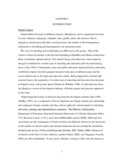Please use this identifier to cite or link to this item:
https://elibrary.tucl.edu.np/handle/123456789/951Full metadata record
| DC Field | Value | Language |
|---|---|---|
| dc.contributor.author | Simkhada, Sharad Chandra | - |
| dc.date.accessioned | 2021-07-20T06:57:20Z | - |
| dc.date.available | 2021-07-20T06:57:20Z | - |
| dc.date.issued | 2007 | - |
| dc.identifier.uri | http://elibrary.tucl.edu.np/handle/123456789/951 | - |
| dc.description.abstract | Hierarchical social structure and norms are pervasive in caste-based society of Nepal. The Dalits fall at the bottom of societal framework. In this context, this study deals with inclusion and exclusion of the Dalit children in a formal Nepalese school. Specific objectives of this research endeavor were: a) to assess caste discrimination in the community, and b) to find out the situation of inclusion of Dalit students in formal education. I reviewed literatures on concept of inclusion, policy, caste and relevant previous researches. A school from Gorkha district was selected for the study. The Dalit students studying in the school were units of study. Their perception towards inclusion was focal point of the study. I generated information by employing qualitative case study method. The case materials were identified and purposively sampled. I also interviewed students, teachers and parents, and observed some phenomena in the school and the community in the course of field study. As I found caste discrimination is on decrease order in the community, however, some discriminatory practices were observed and heard during my study period. Most of the non- Dalits such as Brahmans, Chhetris, Newars, Magars, Gurungs, and Gharti are still sensitive about commensal rules and caste related taboos. At the same time, wealthy and educated Dalits are being increasingly assimilated in social gatherings. The Dalits who are involved in patron-client relationships are incorporated in ceremonies of the so-called higher caste community functions such as marriage, Bratabandha (sacred thread wearing ceremony) and worship of ancestral deity. However, the Dalits concerned have to maintain certain distance especially in sitting and eating. In comparison to the social behaviors in the community, treatment with the Dalit students in the school is less discriminatory. I have analysed their inclusion in terms of behavior, policy and representation. The Dalit students are equally treated inside the school compound. They have access to stay in hostel with other caste pupils. In the policy document particularly the SIP, there is not a single word which indicates inclusion. The teachers are mostly found unfamiliar about the national and international discourse of inclusion. Regarding representation, there is a Dalit teacher and there are two Dalit members in Parent Teachers' Association. From the viewpoint of inclusion, there is good practice in the school in comparison to other schools in the surrounding. Despite blanket treatment in the school, Dalit students have lower performance in education. Because of caste discrimination in the community, they still have humiliation and they are hesitant to establish good relationships with talented friends for collegial learning. Their participation in school activities has been lower. In comparison to the non-Dalit students, they face several problems at school and home. They lack negotiation skill to cope with the problems and to mold the situation in their favour. Their parents were found indifferent and unable to provide them educational support. Therefore, they need counseling from teachers in addition to regular teaching. To meet the requirement, curriculum needs to be made inclusive. Apart from this, capacity of the teachers to be accommodative requires to be built through inclusive training package. | en_US |
| dc.language.iso | en_US | en_US |
| dc.publisher | Faculty of Education | en_US |
| dc.subject | Students | en_US |
| dc.subject | School | en_US |
| dc.title | Inclusion of Dalit Students in a Formal School | en_US |
| dc.type | Thesis | en_US |
| local.institute.title | Faculty of Education | en_US |
| local.academic.level | M.Phil. | en_US |
| Appears in Collections: | English Language Education | |
Files in This Item:
| File | Description | Size | Format | |
|---|---|---|---|---|
| Cover page(6).pdf | 22.58 kB | Adobe PDF |  View/Open | |
| Chapter Page(1).pdf | 294.45 kB | Adobe PDF |  View/Open |
Items in DSpace are protected by copyright, with all rights reserved, unless otherwise indicated.
